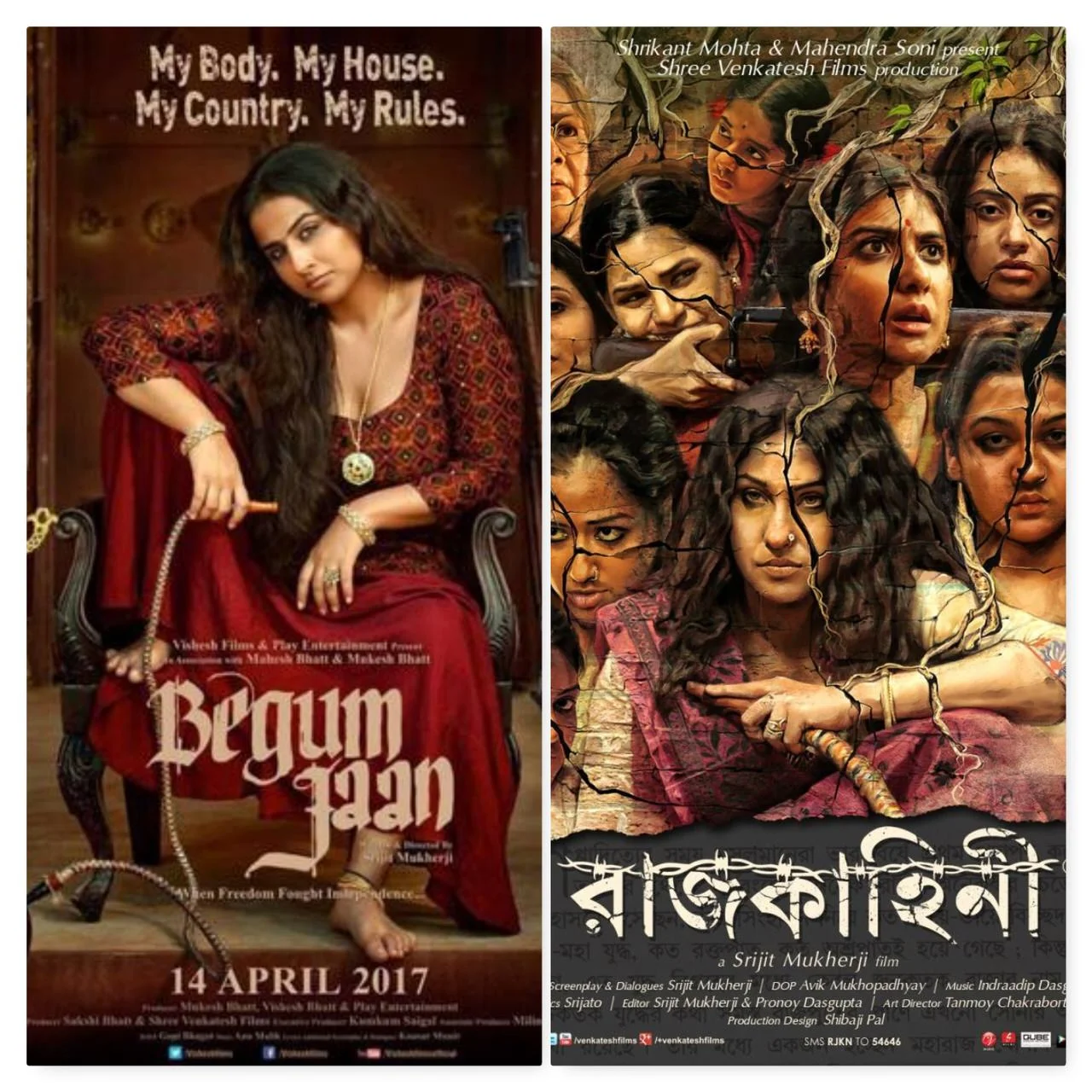The Indian film industry is not just restricted to Bollywood, but also expands to other regional film industries and forms of cinema which has brought up different topics touching the hearts of regional audiences and have struck a chord with them.
Rajkahini was such a movie which had raised high hopes amongst the Bengali film lovers and had created a lot of anticipation in it’s promotional stage. Recently, the move was remade into a Bollywood film called Begum Jaan, starring Vidya Balan.
One of the reasons the original film (Rajkahini) was so heavily anticipated is because the woes of partition still strike a chord with Bengali and the North Indian audiences. The nature and the magnitude of the violence that had occurred during the partition is something that will echo across generations to come. It’s a wound which seems to re-kindle grief and pain every now and often and hence retains it’s niche in the memory of the individuals as well as communities. The release and the eventual success of the film was a sign of how much the story of partition still creates an impression on the audiences.
Rajkahini’s success made it quite natural for it to deserve a big Bollywood break! Bollywood, however, we must remember, has a much wider reach and hence will give the film a wider exposure than the regional languages. As Ben Parker, Spiderman’s uncle had said, “With great power, comes great responsibility” and Bollywood gives you a great deal of power but in order to contain that power, you have to have a couple of responsibilities which you must fulfil. Begum Jaan, the Bollywood re-make of Rajkahini is powerful, very powerful, and it has been able to become so powerful because Begum Jaan has been the dutiful follower of the rules set down by Bollywood.
The story circulates around Begum Jaan – the owner of a kotha (brothel) – on the border of East Pakistan and India, who has over the years taken in women who had been sexually assaulted or ostracized by their families and society, and made them her own. These women took charge of their bodies, their sexualities and over the years used their bodies to earn a livelihood, all under the guidance of Begum Jaan. The trouble starts when the British are departing from India and partition is dividing the land into two countries, India and Pakistan. The Radcliffe line, which acts as the border between the two countries is supposed to pass through the kotha of Begum Jaan and she and her women are asked to vacate the house. What follows next is a tussle for power and a struggle for existence which escalates to tremendous levels. Begum Jaan follows the same story as Rajkahini but puts in a little more visual symbolism in the narrative.
Rajkahini transforms itself with Begum Jaan, into a format which suits and is ‘accepted’ by the mainstream audience. The name Rajkahini was best suited for the Bengali film, because it literally translated into The Story of the Raj, i.e. the British Raj. It was a story which was based on the dynamics of the British Raj and how with the end of the Raj, came the tragic incident of partition. The hero of Rajkahini is the Partition and how Partition manipulated the lives of these women who were otherwise miniscule and irrelevant in society.
Like every Bollywood film, there is a ‘hero’ who leads the film and the story surrounds the life and activities of that ‘hero’. Don’t get me wrong, Begum Jaan is a women-centric film, and all the women in the film are quite good in their performances. But what is problematic with the film is that in order to stick to contemporary Bollywood trends, the film has centered all it’s focus around the leading lady, played by Vidya Balan. And thus, what was essentially a story of partition and the violence meted out towards women during partition, becomes a film which mostly centers around the power which is yielded by the ‘malkin‘ of the ‘kotha‘, Begum Jaan. The narrative of the film makes the character of Begum Jaan the source of all limelight for the film, and Partition – the original ‘hero’ – takes a backseat.
Everything from the posters to the change in the name of the film screams the fact that Begum Jaan is THE woman to be seen, this is her story. When the narrative of the film is observed closely, the stark difference in the original and the Bollywood version are highlighted. The stories which are told by ‘Amma’, played by Ila Arun, are stories describing women who are highly respected in the context of Indian history. Rani Lakshmibai, Sant Meerabai, Begum Razia Sultana, were all strong-willed women who have fought against societal odds to uphold their place and their beliefs. Thus, one is convinced that the film does try to show how a woman is trying to fight for survival and hold onto her power despite the fact that there is a tussle for power in the political premise of the film.
When I finished watching Begum Jaan, I remembered why I found Rajkahini problematic in the first place, despite it being a well-written film. Since the former is a scene-by-scene copy of the latter, hence the problem which existed in the story line of the original film has extended itself to the Bollywood version as well. This problem is actually quite starkly highlighted in Begum Jaan, because quite evidently, Begum Jaan tries to portray the power struggles of a woman in a changing political scenario which is completely controlled by men. She believes she is the one who controls all the men around her because she holds the key to all of their desires, the Raja, the police, the government officials, but she does not realize how all of these men are using her and manipulating her for their personal needs.
By presenting Begum Jaan and her women as fiercely strong-willed, director Srijit Mukherjee creates a particular character sketch for these women. These women are in charge of their bodies, hence they are liberated, autonomous. They are connected by the bond of being sex workers and dealing with its consequent social ostracism, and depend on each other for emotional support. We have always known that women who can take charge of their own lives and who lead life on their own terms are problematic for the society and hence at some point or the other have to be removed from their position.
Despite being so autonomous, Begum Jaan is still however, dependent on Raja Sahab (played by Naseeruddin Shah) for her power and the existence of herself and her women. She has to coax and woo him and fulfill his whims and desires in order to get hold of the piece of land she resides on and keep it for herself. The director who creates the image of an empowered woman, himself demolishes this image of empowerment here and then finally in the end when Begum Jaan and her women slowly step back into the burning ‘kotha‘ and happily immolate themselves, thereby performing what resembles a jauhar (mass immolation by women to avoid capture, enslavement and rape, and to uphold the community’s “honour”) as performed by Rani Padmavati. Thus, the tired trope of a woman’s honour (as situated in her body and chastity) being the single most important thing to preserve in society, more important than death or suicide, is reinstated, destroying the progressive portayal of emancipated, sexually autonomous women that was initially created.
The clash in the images which are portrayed by the film created confusion in my mind, because what seemed like an empowering film in the beginning, reinstated the same patriarchal notion of women’s honour to be protected. Sex workers are on the one hand perceived to be immoral and unchaste and are ostracized from the society in order to protect the honour of domestic life. On the other hand however, when the country is being divided into two halves, the honour of sex workers suddenly becomes important. Do their bodies then represent the country and the nationality which they belong to? Irrespective of “social standing” that is thrust upon women by society, women, including sex workers, are seen to be defined by a distorted concept of honour and virtue.
Whatever may be the case, Begum Jaan reinstates the fact that women are objects of desire and also commodities which can be utilised in accordance to the kind of need that arises, whether it’s for entertainment, or sexual desire, or for independence and nationalistic honour.
Also Read: Deconstructing the ‘Rape Is Worse Than Death’ Conception
About the author(s)
Megha has done her Masters in Women’s Studies from TISS, Hyderabad. She enjoys reading, writing and research on feminism, culture and social issues. She is a Bong and foodie. She tweets @marik_megha.





I wholeheartedly applaud the author and this article.
When I was young and impressionable, i watched a movie with my cousins. In the movie, a minor character commit suicide after she is raped and the audience, including many women, applauded her courage to do that instead of having to live in a world where she had lost her honour. And, young that i was, i asked why the man who raped her did not lose honour and why a woman’s “honour” was linked to her body. Also why it was more important than her life. They told me i would not understand since I was young. I am 30 now, and I still dont understand why the burden of honour is on women, when men rape her, ridicule her in schools colleges, work spaces and even her own home?. I know the answer is Patriarchy and its misogyny that’s ever present in every waking minute of life.
And it is showcased brilliantly on the movie screens with gilt frames, punch dialogues and women more or less representing furniture. Expecting more for movies that proclaim themselves to be women-centric has turned out to be disheartening. They only want more advertising and higher footfall from women in the theatres.
When will we ever have a Ghostbusters (2016) in India? One can wish..